Radiant heating provides zoned comfort and efficiency to log cabin home
New Jersey hydronics pro passes his knowledge to the next generation.

Mike Guglielmo, a 30-year industry veteran, is currently working on a radiant heating project for a 9,200-square-foot luxury log cabin, located about 40 minutes outside of Easton, Pennsylvania, across the New Jersey border. All images courtesy of Priscilla Klenke / 59 Photography.
At 62 years old, Mike Guglielmo has been in the hydronics industry for 30 years. After graduating college with a degree in mechanical engineering, Guglielmo decided he’d rather design/build over sitting behind a desk.
“I found the heating industry very interesting, in particular hot water heating, radiators, radiant floor and baseboard heat,” he says. “It caught my attention, and I ran with it.”
He started Fineline Plumbing & Heating in 1994, a primarily residential service and new construction company. About 80% of his business is radiant heating with the other 20% being plumbing. Most of Fineline’s business comes from word-of-mouth.
“As energy prices rise, people are really waking up and saying, ‘OK, we have to pay attention. We can't just put in the least expensive hot air system. It's uncomfortable. It's expensive to operate,’” he explains. “While it might be cheap upfront, people have really become much more educated on the options that are available. We just stay in the residential market, and I get a lot of satisfaction out of it. People really appreciate the product. It becomes a long-term relationship. I have homes that I've serviced for 30 years. I've watched children grow and grandchildren born.”
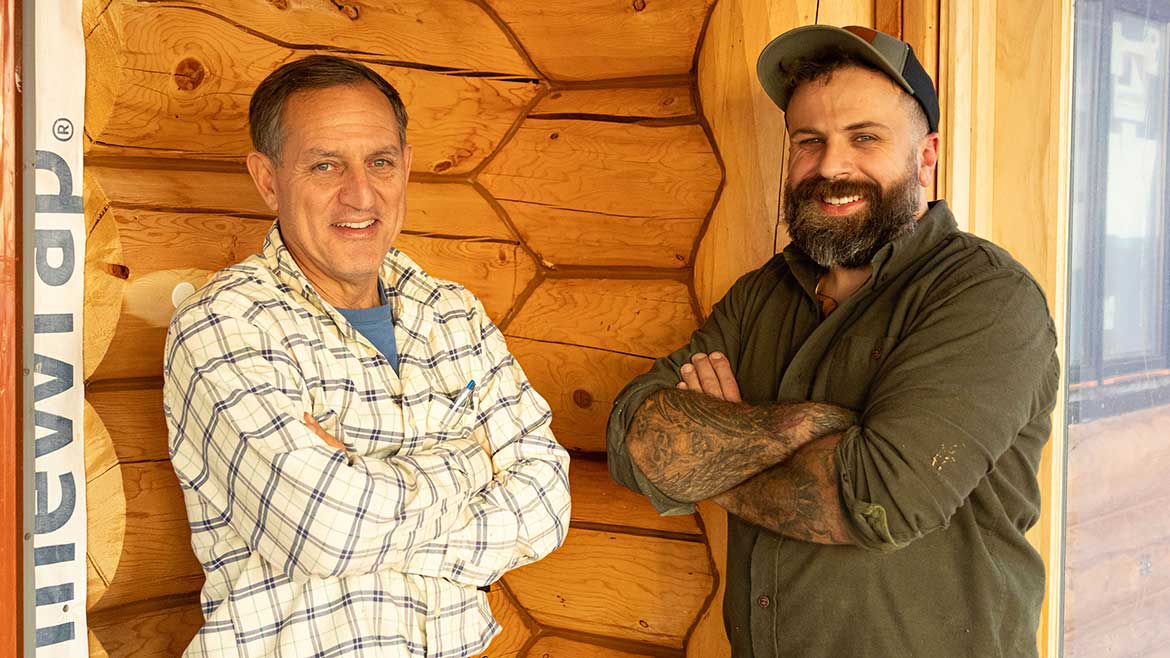
Mike Guglielmo (left), owner of Fineline Plumbing, with his apprentice, Cody DeTorres (right) on a radiant heating job for a log cabin.
Over the last few years, Guglielmo downsized his business until it was just him as he got ready to retire. He had one foot on his sailboat when Cody DeTorres, a friend’s son, came knocking, asking to apprentice under him to earn his master plumbing license in New Jersey.“Cody's dad and I are very good friends, and we're very close,” Guglielmo says. “And over the years, his dad and I worked together. When I decided to do more work in South Jersey, his dad stayed more in North Jersey. Cody has worked for his father and he's worked for his uncle, who had a very large plumbing company. I think he's picking and choosing who he wants to learn from.
“I wish there were more guys like Cody who want to learn the industry,” he continues. “All these new products are all high-tech. And we need people who are going to learn the technology. I see the plumbers near me installing Navien water heaters and Triangle Tube boilers, but they never come back to service them because they don't know what they just installed and they don't learn. I’m thrilled that Cody’s interested — it’s fun and it’s highly technical.”
DeTorres wishes he had started apprenticeship sooner, but his parents pushed him toward college and a degree in journalism before he figured out it wasn’t what he wanted to pursue.
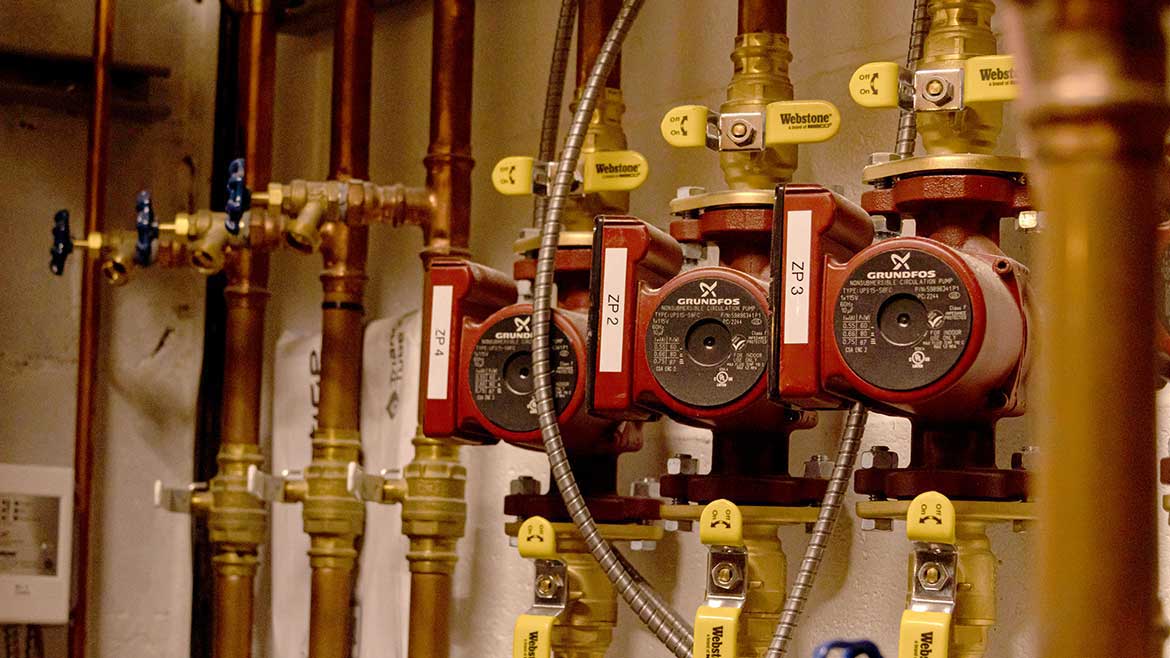
The radiant heating system uses Grundfos 3-speed circulators and Webstone valves.
“I have my own company I operate out of Pennsylvania,” DeTorres says. “But in order for me to get a New Jersey master plumber’s license, I have to apprentice under a New Jersey master plumber. Mike actually apprenticed with my dad back in the early 1990s, and I’ve known him forever. This was kind of a nice favor for him to repay to me to be able to apprentice under him. I wouldn't want to just do it under any Joe Schmo. I've had the pleasure of working with way above average plumbers all my life, with Mike, my dad and my uncle.”
This is DeTorres’ second year apprenticing under Guglielmo, and he has three more to go before he is able to sit for the New Jersey master plumber license test.
“I can’t thank Mike enough for teaching me what he does,” DeTorres adds. “He's helped me with so many other jobs, especially jobs of my own in Pennsylvania when it comes to heating and helping design stuff. I have a huge love for this trade. Mike recognizes that. My whole left arm is covered in plumbing tattoos. I have a RIDGID ad from the 1950s, the Statue of Liberty holding the pipe wrench, and the inside of a wall that's ripped open that has a bunch of plumbing in it. My latest one is of the Grundfos pumps that we put in. I don’t look at it as a job — I don’t even feel like I’m going to work half the time. It might be frustrating and tiring, my knees and feet kill me sometimes, but at the end of the day, it’s such a rewarding trade to be part of and be able to do such high quality work.”
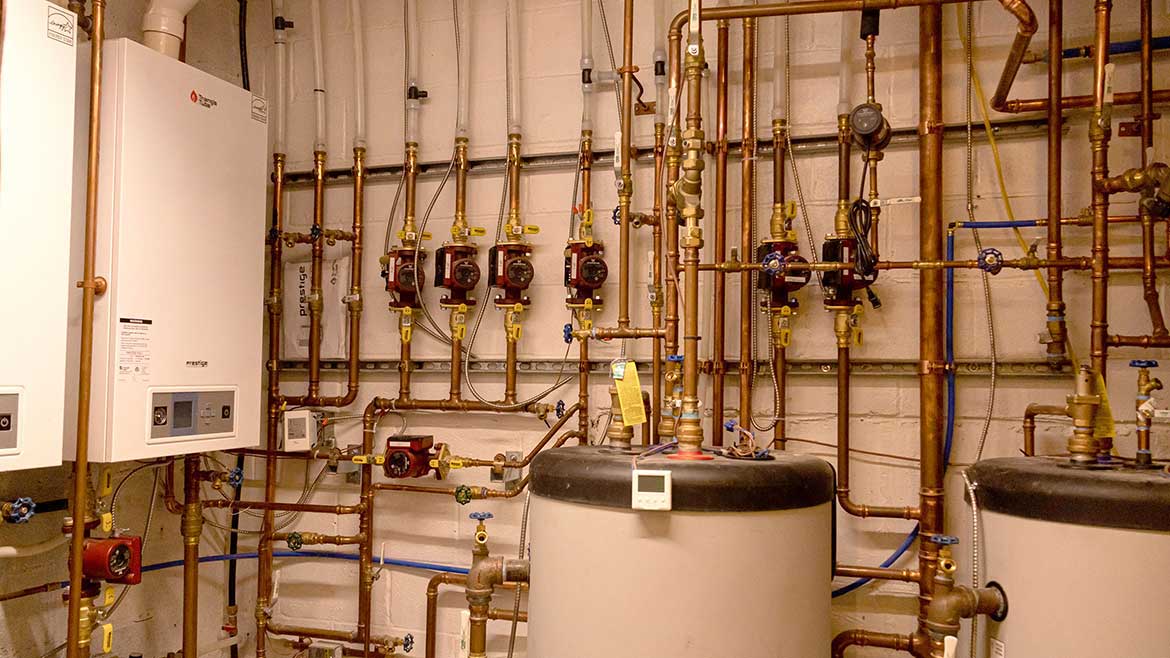
Guglielmo also used two Triangle Tube Smart 80 indirect water heaters fitted with Caleffi angle thermostatic mixing valves in the radiant heating system design.
A unique project
Guglielmo’s latest project is a radiant heating system for a log cabin, located about 40 minutes outside Easton, Pennsylvania, across the New Jersey border. The homeowner was actually referred to him by DeTorres’ father, Rich DeTorres.
The 9,200-square-foot luxury home features a bar/lounge, home theater, cigar room and four seasons room. Everything is controlled with tekmar Net Gateway for remote access. The basement features 3,000 square feet of concrete with Viega Rapid Grid insulated panels and 1/2-inch PEX radiant tubing for three heating zones; the main floor features 3,600 square feet with 3/4-inch grooved plywood panels for 1/2-inch Uponor Heat PEX radiant tubing and seven heating zones; and the second floor features 2,600 square feet with 3/4-inch grooved plywood panels for 1/2-inch Uponor Heat PEX radiant tubing and five heating zones.
One of the greatest challenges contractors face is fitting all the equipment inside the mechanical room, which seems to be getting smaller and smaller. Guglielmo and DeTorres had to share the 15-foot by 6-foot space with an HVAC air handler, water softener, neutralizer and UV treatment equipment. The radiant heating system is powered by two Triangle Tube Prestige Solo 155,000 Btu fire-tube gas boilers, converted to propane, along with two Triangle Tube Smart 80 indirect water heaters fitted with Caleffi angle thermostatic mixing valves, Grundfos 3-speed circulators, Uponor radiant heating manifolds and actuators, a tekmar TN2 control system for outdoor reset hydronic temperature control, domestic hot water production, injection mixing for two temperatures of radiant heating, and remote sensors for hidden thermostats. The tekmar Gateway adds a remote connectivity element to the system.
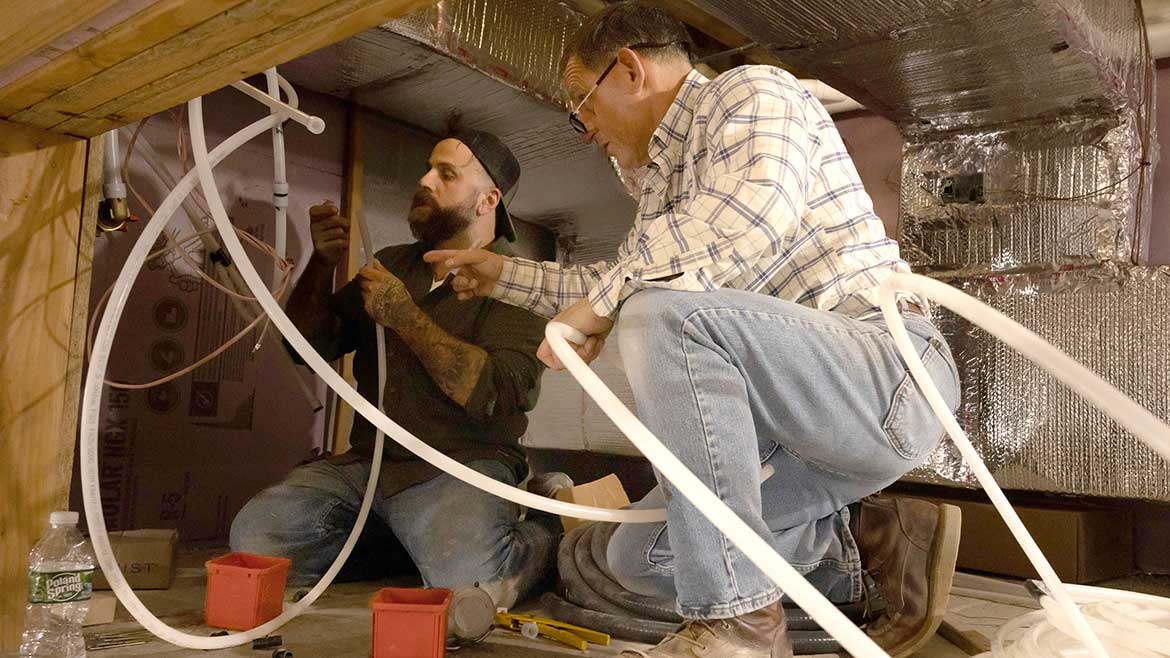
Guglielmo and DeTorres installed 3,600 square feet of 3/4-inch grooved plywood panels for 1/2-inch Uponor Heat PEX radiant tubing and seven heating zones on the main floor, and 2,600 square feet of 3/4-inch grooved plywood panels for 1/2-inch Uponor Heat PEX radiant tubing and five heating zones on the second floor. The basement features 3,000 square feet of concrete with Viega Rapid Grid insulated panels and 1/2-inch PEX radiant tubing with three heating zones.
“It’s a really unique home — it almost looks like a lodge,” Guglielmo notes. “The homeowner had just heard in conversation that radiant heat was the best heat —it was comfortable and efficient. He’s in an area where he can only get propane gas, which is expensive. He knew if he had an efficient system, he would use less fuel and be more comfortable. He asked the architect, who asked the builder, and when he finally got to Rich DeTorres, Rich said, ‘Locally, this is who you should talk to.’ His main decision to use radiant was comfort, and the energy savings was a benefit. It made it easy to sell.”
The logs were shipped in from Montana. According to Guglielmo, the home was preassembled in Montana, then broken down and shipped to New Jersey. Then, a team from Montana came and assembled a large majority of the structural part of the house with all the logs.
“There’s not a single piece of drywall in the house,” he says. “Even the finished walls are all exposed logs — 14 inch diameter by 40 feet long.”
“It was a little scary being there when they were building it because they were swinging trees over your head,” Cody DeTorres adds.
Controlled comfort
One of the advantages to installing radiant heating is the ability to create independent zones, Guglielmo notes.
“Because of the way the systems are built, you can have a lot of thermostats — that gives you comfort and efficiency as well as massive control. If you have an elderly visitor, they don’t rely on you to make the room warmer. Each bedroom and bathroom has a thermostat, but that layout does translate to a fairly complicated control system.”
The homeowner wanted a smart home control to be able to control the system, so Guglielmo went with tekmar. “The unique thing about tekmar is we are able to control the entire heating and cooling system with one app,” Guglielmo explains. “The homeowner doesn’t care that the HVAC guy did the sheet metal work and we did the radiant. He just wants one control system. So we took over control of the air conditioning so he won’t need multiple apps to control climate. That's a unique feature, and it's all addressable from any device.”
The way the house was built was one of the challenges Guglielmo and DeTorres had to overcome.
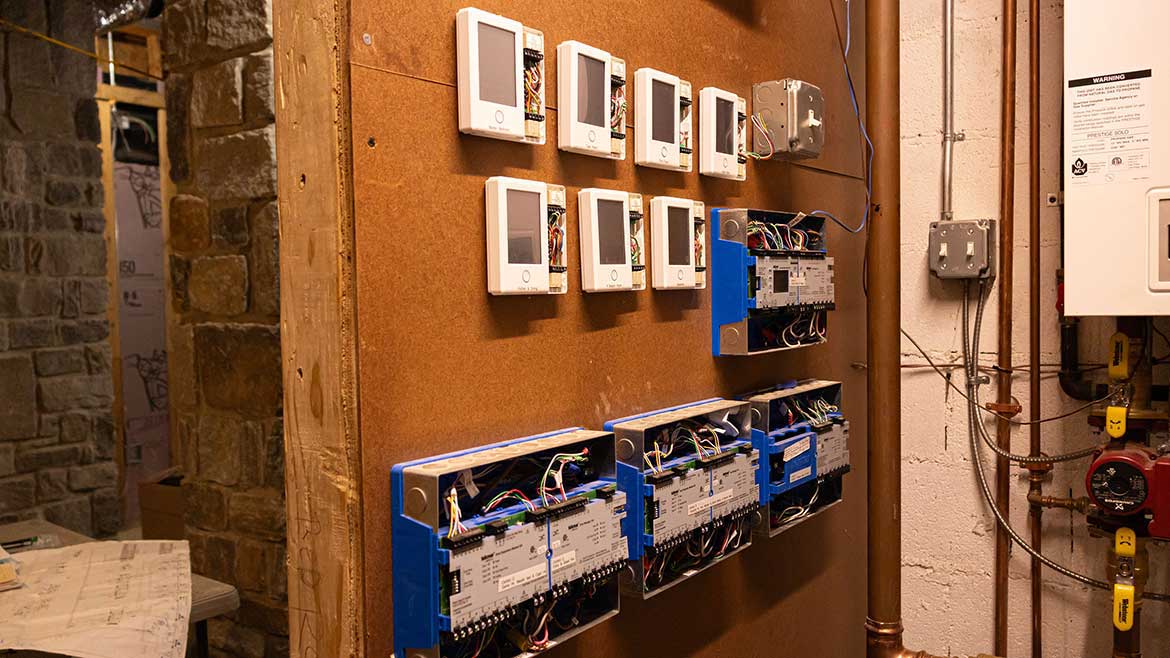
The homeowner wanted a smart home control to be able to control the system, so Guglielmo went with tekmar.
“There’s multiple ways to do radiant, but because this house was designed, assembled, broken down and shipped, we had no choice but to use grooved plywood subfloor,” Guglielmo explains. “Imagine the house is built, and now we put down what amounts to a jigsaw puzzle every room. We put down grooved plywood with the piping layout in mind. We do a computer-generated piping layout initially, but when we build it, there's always an obstacle, so we're constantly adjusting.”
The board goes down and the tubing is installed, then the system is pressure tested with air.
“If that passes, then we build a distribution system with manifolds and pumps,” Guglielmo says.
Additionally, since the walls are made of logs, all of the electrical outlets and lighting is in the floor. That created obstacles in the radiant heating design. And, because of the weight of the logs, there was a lot of steel and microllam used to support the structure.
“All of that became obstacles for hot water piping,” Guglielmo notes. “We burnt through drill bits and broke our knuckles just trying to do our supply and return piping.”
Tried and true
Guglielmo has been using Triangle Tube products for 20 years and never had an issue, so that’s what he chose for this project. He opted for Uponor tubing because of its incredible flexibility and because it’s quiet. The basement was done with Viega before Guglielmo was involved.
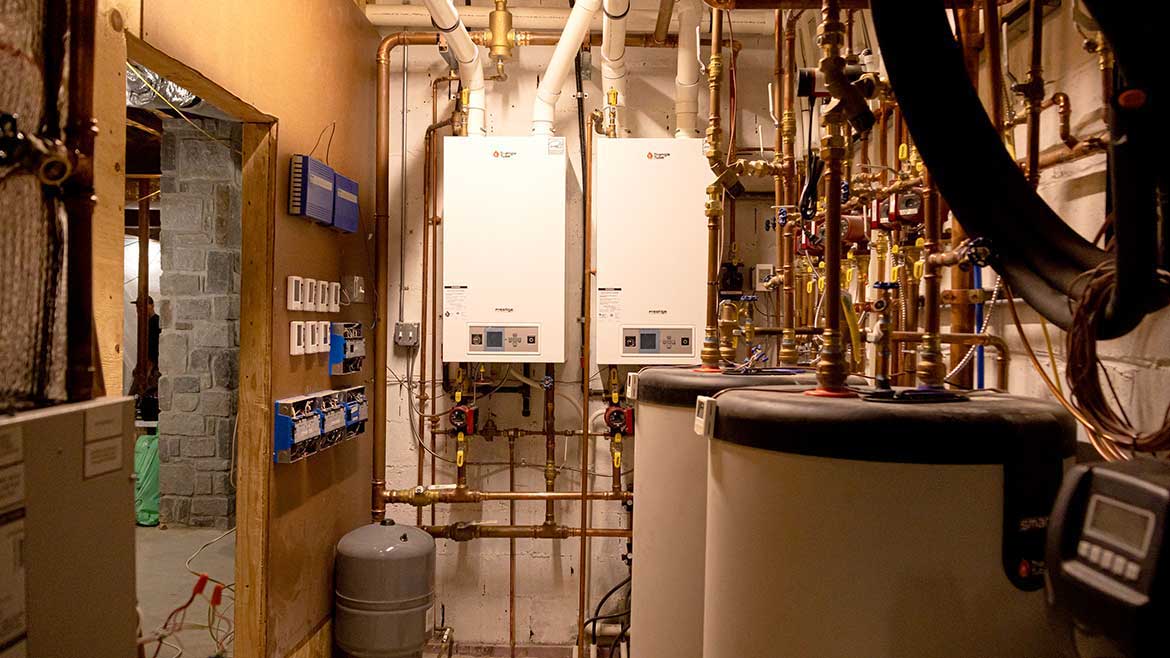
The radiant heating system is powered by two Triangle Tube Prestige Solo 155,000 Btu fire-tube gas boilers, converted to propane
“The house has two different tubes, which is great because it’s two brands that are excellent,” he notes. “They’re both at the top of their game. We went with Uponor manifolds because if we’re going to service it, those are the products and parts we stock. You go through your trials as you gain experience, but I’ve found with Grundfos, Uponor and Triangle Tube, I have the least amount of callbacks with the most reliability. Take it out of the box, turn it on and it works the way it’s supposed to. The companies are supportive, and if I need help, I can get it from the rep or from the manufacturer itself.”
The homeowner plans to take up residence in January. There are also plans to add a snow-melting system to the property’s driveway and porches.
Inspiring next generation of hydronics installers
Guglielmo prefers hydronics jobs because of the satisfaction.
“It’s a unique product and system,” he explains. “There aren't a lot of people that do it. And honestly, every new job is exciting for us because they're never the same. Every one is different. Every one is a design you bring it to fruition, and it's a good feeling. And we always have relationships with our customers at the end. It's not ‘Thank you,’ and they forget us. They recommend us. It's a tremendous amount of satisfaction. It's also highly technical, so your brain is on the whole time. Even during the installation, after it's designed, there are job site problems that appear and you have to solve them —there's a good amount of fun to it.”
DeTorres is thrilled to be learning from such a hydronics pro. It’s the direction he wants to take his own career.
“I’ve been on so many plumbing projects over the years that were just so monotonous — just the same thing over and over again,” he says. “This kind of hydronic work, it makes you think constantly. Everything from the layout of the boiler room, wiring and stuff like that to the layout of the tubing is important ¬— it's not just cut and dry. You really have to think about it. Learning this kind of insane heating from Mike is incredible. It’s really where I want to be in my career.”
Looking for a reprint of this article?
From high-res PDFs to custom plaques, order your copy today!









